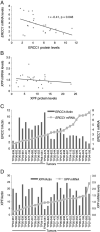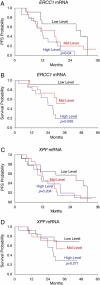Comparison of ERCC1/XPF genetic variation, mRNA and protein levels in women with advanced stage ovarian cancer treated with intraperitoneal platinum
- PMID: 22609620
- PMCID: PMC3518863
- DOI: 10.1016/j.ygyno.2012.05.006
Comparison of ERCC1/XPF genetic variation, mRNA and protein levels in women with advanced stage ovarian cancer treated with intraperitoneal platinum
Abstract
Objective: Approximately 20% of patients receiving platinum-based chemotherapy for epithelial ovarian cancer (EOC) are refractory or develop early recurrence. Identifying these patients early could reduce treatment-associated morbidity and allow quicker transfer to more effective therapies. Much attention has focused on ERCC1 as a potential predictor of response to therapy because of its essential role in the repair of platinum-induced DNA damage. The purpose of this study was to accurately measure protein levels of ERCC1 and its essential binding partner XPF from patients with EOC treated with platinum-based therapy and determine if protein levels correlate with mRNA levels, patient genotypes or clinical outcomes.
Methods: ERCC1 and XPF mRNA and protein levels were measured in frozen EOC specimens from 41 patients receiving intraperitoneal platinum-based chemotherapy using reverse transcription polymerase chain reaction and western blots. Genotypes of common nucleotide polymorphisms were also analyzed. Patient outcomes included progression free (PFS) and overall survival (OS).
Results: Expression of ERCC1 and XPF were tightly correlated with one another at both the mRNA and protein level. However, the mRNA and protein levels of ERCC1 were not positively correlated. Likewise, none of the SNPs analyzed correlated with ERCC1 or XPF protein levels. There was an inverse correlation between mRNA levels and patient outcomes.
Conclusion: Neither genotype nor mRNA levels are predictive of protein expression. Despite this, low ERCC1 mRNA significantly correlated with improved PFS and OS.
Copyright © 2012 Elsevier Inc. All rights reserved.
Figures




Similar articles
-
[Polymorphisms of ERCC1 gene and outcomes in epithelial ovarian cancer patients with platinum-based chemotherapy].Zhonghua Fu Chan Ke Za Zhi. 2013 Nov;48(11):847-52. Zhonghua Fu Chan Ke Za Zhi. 2013. PMID: 24444563 Chinese.
-
The role of single nucleotide polymorphisms of the ERCC1 and MMS19 genes in predicting platinum-sensitivity, progression-free and overall survival in advanced epithelial ovarian cancer.Gynecol Oncol. 2013 Aug;130(2):377-82. doi: 10.1016/j.ygyno.2013.04.054. Epub 2013 Apr 28. Gynecol Oncol. 2013. PMID: 23632208
-
Prediction of response to chemotherapy by ERCC1 immunohistochemistry and ERCC1 polymorphism in ovarian cancer.Int J Gynecol Cancer. 2008 Jul-Aug;18(4):702-10. doi: 10.1111/j.1525-1438.2007.01068.x. Epub 2007 Oct 24. Int J Gynecol Cancer. 2008. PMID: 17961161 Clinical Trial.
-
[ERCC1 as a Marker of Ovarian Cancer Resistance to Platinum Drugs].Antibiot Khimioter. 2015;60(3-4):42-50. Antibiot Khimioter. 2015. PMID: 26415382 Review. Russian.
-
The prognostic and predictive value of excision repair cross-complementation group 1 (ERCC1) protein in 1288 patients with head and neck squamous cell carcinoma treated with platinum-based therapy: a meta-analysis.Eur Arch Otorhinolaryngol. 2016 Sep;273(9):2305-17. doi: 10.1007/s00405-015-3710-x. Epub 2015 Jul 16. Eur Arch Otorhinolaryngol. 2016. PMID: 26179868 Review.
Cited by
-
Disruption of DNA repair in cancer cells by ubiquitination of a destabilising dimerization domain of nucleotide excision repair protein ERCC1.Oncotarget. 2017 Jul 21;8(33):55246-55264. doi: 10.18632/oncotarget.19422. eCollection 2017 Aug 15. Oncotarget. 2017. PMID: 28903417 Free PMC article.
-
New Insights into Mechanisms of Cisplatin Resistance: From Tumor Cell to Microenvironment.Int J Mol Sci. 2019 Aug 24;20(17):4136. doi: 10.3390/ijms20174136. Int J Mol Sci. 2019. PMID: 31450627 Free PMC article. Review.
-
Genetic risk factors for chemotherapy-induced nausea and vomiting in patients with cancer receiving cisplatin-based chemotherapy.Support Care Cancer. 2018 May;26(5):1505-1513. doi: 10.1007/s00520-017-3974-3. Epub 2017 Nov 24. Support Care Cancer. 2018. PMID: 29177570
-
The Prognostic and Predictive Role of Xeroderma Pigmentosum Gene Expression in Melanoma.Front Oncol. 2022 Jan 31;12:810058. doi: 10.3389/fonc.2022.810058. eCollection 2022. Front Oncol. 2022. PMID: 35174087 Free PMC article.
-
An explorative analysis of ERCC1-19q13 copy number aberrations in a chemonaive stage III colorectal cancer cohort.BMC Cancer. 2013 Oct 21;13:489. doi: 10.1186/1471-2407-13-489. BMC Cancer. 2013. PMID: 24144331 Free PMC article.
References
-
- Vergote I, van Gorp T, Amant F, Leunen K, Neven P, et al. Timing of debulking surgery in advanced ovarian cancer. Int J Gynecol Cancer. 2008;18(Suppl. 1):11–9. - PubMed
-
- Escobar PF, Rose PG. Docetaxel in ovarian cancer. Expert Opin Pharmacother. 2005;6:2719–26. - PubMed
-
- Piccart MJ, Bertelsen K, James K, Cassidy J, Mangioni C, et al. Randomized intergroup trial of cisplatin-paclitaxel versus cisplatin-cyclophosphamide in women with advanced epithelial ovarian cancer: three-year results. J Natl Cancer Inst. 2000;92:699–708. - PubMed
-
- McGuire WP, Hoskins WJ, Brady MF, Kucera PR, Partridge EE, et al. Cyclophosphamide and cisplatin compared with paclitaxel and cisplatin in patients with stage III and stage IV ovarian cancer. N Engl J Med. 1996;334:1–6. - PubMed
-
- Ozols RF, Bundy BN, Greer BE, Fowler JM, Clarke-Pearson D, et al. Phase III trial of carboplatin and paclitaxel compared with cisplatin and paclitaxel in patients with optimally resected stage III ovarian cancer: a Gynecologic Oncology Group study. J Clin Oncol. 2003;21:3194–200. - PubMed
Publication types
MeSH terms
Substances
Grants and funding
LinkOut - more resources
Full Text Sources
Medical

